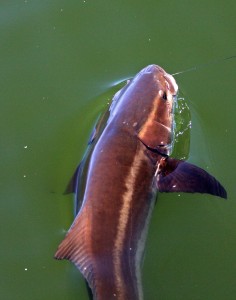 Cobia arrive in our waters about May 20th. The first citations are usually registered Memorial Day Weekend. They will usually stay through September. Cobia can be caught many different ways. The three most popular ways in the bay are chumming, structure fishing, and trolling.
Cobia arrive in our waters about May 20th. The first citations are usually registered Memorial Day Weekend. They will usually stay through September. Cobia can be caught many different ways. The three most popular ways in the bay are chumming, structure fishing, and trolling.
The chumming season begins in late May and can continue through September. Early in the season, two of the best areas are Bluefish Rock and the whole stretch between the James and Back Rivers. In general, find a spot with 10-20 feet of water, not too close to other boats or crab pots (good luck!).Anchor up and start chumming.
Have a float of some sort tied to your anchor line so that you can untie and get away from your anchor in a hurry if need be. You can grind your own chum, but most will buy frozen, ground menhaden from local tackle shops or seafood houses. You can buy chum pots, make your own, or use an onion sack or burlap bag. I chum top and bottom. My surface chum pot is a five gallon bucket with holes drilled in it. My bottom chum pot is a minnow trap with a diver’s weight in it to get it to the bottom. Use fairly heavy tackle for these fish that can push 100 pounds. 30 pound class is about right. Use a fish finder rig with enough weight to keep your bait on the bottom. Your leader needs to be short enough for casting. Hook size should be based on the bait that you are using, a 7/0 is a good starting point. Circle hooks work well. Place out as many rods as your fishing party can clear in a hurry, the more rods the more tangles. In addition to the baits on the bottom, you can place a bait or two on the surface using a cork or balloon to keep it off the bottom. I don’t do this anymore because almost all of my fish have been caught on the bottom. I do keep a rod ready to cast to a surface swimming cobia ( I do this all summer no matter what I am fishing for). Most cobia fishermen will leave their reels in free-spool with the clicker on. They will let the cobia run with the bait for a bit before setting the hook. I leave mine in gear and let the cobia hook itself. Cobia will eat just about anything but can be picky at times. Any small, legal sized fish can be used as bait. Croaker, spot, pigfish, gray trout, and bluefish are the most available. Eels are an area favorite. Cut bait also works well, fresh menhaden and bluefish are good. Peeler crab works great if you can keep it away from the bait stealers. As the season progresses, York Spit Light, Latimer Shoal, the Inner Middle Ground of the CBBT, and the deeper areas of the Hump and 36A (old C10) become good areas.
Structure fishing is best from late July through September. The major areas are the buoy lines, the CBBT, and the Chesapeake Light Tower. Casting to visible fish, with jigs and live bait, is the usual method. Early in the morning and during light current are the most productive times. You can add some weight to your line and drift your baits past a productive buoy for deeper fish. The trick is getting the fish away from the structure. Some people will use light drags and try to tease the fish away, I use a heavy drag and try to horse the fish out. Both ways work sometimes.
Trolling is primarily done along the CBBT and around the shoals near the mouth of the bay. Over the shoals, spoons are the preferred lure. 3 1/2 Drones or number 18 and 19 Pet spoons are good choices. Use an in-line sinker with a 15 to 25 foot leader and slowly troll over and around the shallow water near the northern section of the CBBT. You may catch drum as well as cobia doing this. Along the pilings of the CBBT, I have had good luck slowly trolling green and red surgical eels.
